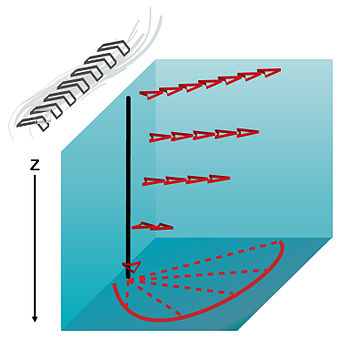埃克曼层

埃克曼层(又称摩擦上层,英语:Ekman layer)是流体中压力梯度力、科氏力和湍流阻力三力平衡的一层。由瑞典海洋学家埃克曼提出。
历史
埃克曼层理论建立的基础是弗里德乔夫·南森在跟随“前进号”(Fram)进行北极探险时的一个发现:冰漂移的角度为盛行风的方向偏右20-40°。之后南森请他的同事威廉·皮耶克尼斯安排一名学生对此问题进行研究。埃克曼被皮耶克尼斯选中,并在1902年他的博士论文中提出了他的成果。[1]
数学表述
埃克曼层数学表达的假定是在中立分层流体中,水平方向上压力梯度力、科氏力和湍流粘性力三力平衡。
,
其中是扩散涡粘度,可由混合长度理论导出。
边界条件
埃克曼层理论适用于许多地区,包括大气层底部(接近地球表面和海洋),大洋底部(海床附近)和表层海水(海气界面附近)。
不同地区有不同的边界条件。下面考虑埃克曼层在表层海水的边界条件[2] :
在
其中是海洋上方表面风或冰层的应力。
在,
其中和是地转流。
解法
求解这些微分方程得到:
式中
注意在北半球对艾克曼螺旋引起的体积输送作垂直积分后,方向为垂直风向向右。
埃克曼层的实际观测
观察埃克曼层有许多困难,主要有两个原因:首先,该理论是过于简单,它假设涡粘度为常量。然而埃克曼自己预期[3] ,在讨论的区域内海水密度不一致时,很显然不能被认为是常量。
其次,设计精度足以观察海洋中流速分布的仪器非常困难。
在大气
在大气中,埃克曼解夸大了水平风场的强度,因为它与表层速度切变无关。将边界层分为表面层和埃克曼层一般会得到更精确的结果。[4]
在海洋
埃克曼层以及它的显着特征:埃克曼螺旋,在海洋中很少看到。靠近海面的埃克曼层大约只有10-20米深,[4]并且直到1980年前后,才有足够敏感的仪器能够观察这一浅层的流速垂直分布。[2]
仪器仪表
只有开发出强大的表面系泊和敏感的海流计,才能观测到埃克曼层。埃克曼自己制作了一个海流计,观察以他的名字命名的螺旋,但没有成功。[5] 矢量测量海流计[6]和声学多普勒流速剖面仪都用于测量海流。
观测
埃克曼螺旋的第一次观测是在1980年的混合层实验中。[7]
参见
- 埃克曼输送
参考文献
- ^ Cushman-Roisin, Benoit. Chapter 5 - The Ekman Layer. Introduction to Geophysical Fluid Dynamics 1st. Prentice Hall. 1994: 76–77 [2009-08-06]. (原始内容存档于2009-07-26) (英语).
- ^ 2.0 2.1 Vallis, Geoffrey K. Chapter 2 - Effects of Rotation and Stratification. Atmospheric and Oceanic Fluid Dynamics 1st. Cambridge, UK: Cambridge University Press. 2006: 112–113 [2009-08-06]. (原始内容存档于2009-01-23) (英语).
- ^ Ekman, V.W. On the influence of the earth's rotation on ocean currents. Ark. Mat. Astron. Fys. 1905, 2 (11): 1–52.
- ^ 4.0 4.1 Holton, James R. Chapter 5 - The Planetary Boundary Layer. Dynamic Meteorology. International Geophysics Series 88 4th. Burlington, MA: Elsevier Academic Press. 2004: 129–130 [2009-08-06]. (原始内容存档于2016-10-16) (英语).
- ^ Rudnick, Daniel. Observations of Momentum Transfer in the Upper Ocean: Did Ekman Get It Right?. Near-Boundary Processes and their Parameterization (Manoa, Hawaii: School of Ocean and Earth Science and Technology). 2003.
- ^ Weller, R.A.; Davis, R.E. A vector-measuring current meter. Deep-Sea Res. 1980, 27: 565–582 [12-08-2008].
- ^ Davis, R.E.; R. de Szoeke, and P. Niiler. Part II: Modelling the mixed layer response. Deep-Sea Res. 1981, 28: 1453–1475 [12-08-2008].
|
Text is available under the CC BY-SA 4.0 license; additional terms may apply.
Images, videos and audio are available under their respective licenses.









![{\displaystyle \ u=u_{g}+{\frac {\sqrt {2)){\rho fd))e^{z/d}\left[\tau _{x}cos(z/d-\pi /4)-\tau _{y}sin(z/d-\pi /4)\right]}](https://wikimedia.org/api/rest_v1/media/math/render/svg/dd395b53d9f998c716fec8124ad0cc1be9bac0a2)
![{\displaystyle \ v=v_{g}+{\frac {\sqrt {2)){\rho fd))e^{z/d}\left[\tau _{x}sin(z/d-\pi /4)-\tau _{y}cos(z/d-\pi /4)\right].}](https://wikimedia.org/api/rest_v1/media/math/render/svg/43d368f4e0c9a774b509e5df68118b2c89b277bb)

![{\displaystyle \ \left[\nu \right]}](https://wikimedia.org/api/rest_v1/media/math/render/svg/9f42e24bd3af001fe2dd599781fc7cef71f07e14)
